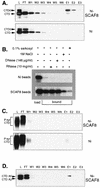A nuclear matrix protein interacts with the phosphorylated C-terminal domain of RNA polymerase II
- PMID: 9528809
- PMCID: PMC121500
- DOI: 10.1128/MCB.18.4.2406
A nuclear matrix protein interacts with the phosphorylated C-terminal domain of RNA polymerase II
Abstract
Yeast two-hybrid screening has led to the identification of a family of proteins that interact with the repetitive C-terminal repeat domain (CTD) of RNA polymerase II (A. Yuryev et al., Proc. Natl. Acad. Sci. USA 93:6975-6980, 1996). In addition to serine/arginine-rich SR motifs, the SCAFs (SR-like CTD-associated factors) contain discrete CTD-interacting domains. In this paper, we show that the CTD-interacting domain of SCAF8 specifically binds CTD molecules phosphorylated on serines 2 and 5 of the consensus sequence Tyr1Ser2Pro3Thr4Ser5Pro6Ser7. In addition, we demonstrate that SCAF8 associates with hyperphosphorylated but not with hypophosphorylated RNA polymerase II in vitro and in vivo. This result suggests that SCAF8 is not present in preinitiation complexes but rather associates with elongating RNA polymerase II. Immunolocalization studies show that SCAF8 is present in granular nuclear foci which correspond to sites of active transcription. We also provide evidence that SCAF8 foci are associated with the nuclear matrix. A fraction of these sites overlap with a subset of larger nuclear speckles containing phosphorylated polymerase II. Taken together, our results indicate a possible role for SCAF8 in linking transcription and pre-mRNA processing.
Figures







Similar articles
-
A serine/arginine-rich nuclear matrix cyclophilin interacts with the C-terminal domain of RNA polymerase II.Nucleic Acids Res. 1997 Jun 1;25(11):2055-61. doi: 10.1093/nar/25.11.2055. Nucleic Acids Res. 1997. PMID: 9153302 Free PMC article.
-
A novel SR-related protein specifically interacts with the carboxy-terminal domain (CTD) of RNA polymerase II through a conserved interaction domain.Biol Chem. 1997 Jun;378(6):565-71. doi: 10.1515/bchm.1997.378.6.565. Biol Chem. 1997. PMID: 9224939
-
Snapshots of the RNA processing factor SCAF8 bound to different phosphorylated forms of the carboxyl-terminal domain of RNA polymerase II.J Biol Chem. 2008 Aug 15;283(33):22659-69. doi: 10.1074/jbc.M803540200. Epub 2008 Jun 11. J Biol Chem. 2008. PMID: 18550522
-
Phosphorylation of the C-terminal domain of RNA polymerase II plays central roles in the integrated events of eucaryotic gene expression.J Biochem. 2007 May;141(5):601-8. doi: 10.1093/jb/mvm090. Epub 2007 Apr 3. J Biochem. 2007. PMID: 17405796 Review.
-
Investigating RNA polymerase II carboxyl-terminal domain (CTD) phosphorylation.Eur J Biochem. 2003 Oct;270(19):3859-70. doi: 10.1046/j.1432-1033.2003.03794.x. Eur J Biochem. 2003. PMID: 14511368 Review.
Cited by
-
Polyadenylation site selection: linking transcription and RNA processing via a conserved carboxy-terminal domain (CTD)-interacting protein.Curr Genet. 2017 May;63(2):195-199. doi: 10.1007/s00294-016-0645-8. Epub 2016 Aug 31. Curr Genet. 2017. PMID: 27582274 Review.
-
The ER repeat protein YT521-B localizes to a novel subnuclear compartment.J Cell Biol. 2000 Sep 4;150(5):949-62. doi: 10.1083/jcb.150.5.949. J Cell Biol. 2000. PMID: 10973987 Free PMC article.
-
Coupled in vitro synthesis and splicing of RNA polymerase II transcripts.RNA. 2000 Sep;6(9):1325-34. doi: 10.1017/s1355838200992537. RNA. 2000. PMID: 10999609 Free PMC article.
-
The WW domain-containing proteins interact with the early spliceosome and participate in pre-mRNA splicing in vivo.Mol Cell Biol. 2004 Oct;24(20):9176-85. doi: 10.1128/MCB.24.20.9176-9185.2004. Mol Cell Biol. 2004. PMID: 15456888 Free PMC article.
-
Splicing and transcription-associated proteins PSF and p54nrb/nonO bind to the RNA polymerase II CTD.RNA. 2002 Sep;8(9):1102-11. doi: 10.1017/s1355838202025037. RNA. 2002. PMID: 12358429 Free PMC article.
References
-
- Allison L A, Moyle M, Shales M, Ingles C J. Extensive homology among the largest subunits of eukaryotic and prokaryotic RNA polymerases. Cell. 1985;42:599–610. - PubMed
Publication types
MeSH terms
Substances
Grants and funding
LinkOut - more resources
Full Text Sources
Molecular Biology Databases
Research Materials
